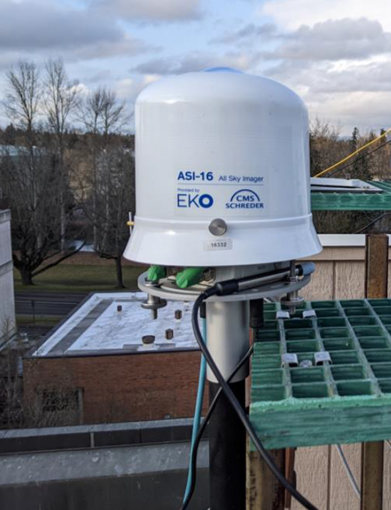Single Axis Tracking via Sky Imaging and Machine Learning
A machine learning model for estimating the optimal angle of photovoltaics on single axis trackers for improved energy production in cloudy conditions
Single axis trackers are commonly used in large photovoltaic (PV) plants to orient the PV modules toward the sun to increase the energy absorbed when the sun is shining. However, when the sun is obscured by a cloud, the PV module orientation that can generate maximum energy may not be the orientation that points the PV module toward the obscured sun. Instead, there may be another orientation, reachable by the tracker, that could allow the PV to collect more irradiance and generate more energy. Finding this orientation is a difficult task, potentially involving complex sensors requiring high maintenance.

Researchers at Sandia have developed a method to estimate the optimal tracker angle using a sky camera. A machining learning (ML) algorithm consisting of a convolutional neural network (CNN) has been taught to estimate the profile of the solar irradiance in a semicircular arc from the east, through the zenith, and then to the west. The estimated irradiance profile can be used to predict the rotational angle of the single axis tracker that would generate the maximum energy from the PV modules.
The technology allows PV system owners with single axis trackers to increase the energy from their PV systems. The energy gain is especially pronounced when the location of the PV system is in an area which experiences frequently cloudy weather conditions and may be as large as 2% annual energy gain. A neural network with several convolutional and dense layers is trained on hemispherical irradiance data to estimate the hemispherical irradiance based on sky images. A convolutional layer is provided with a sky image from a camera with a fisheye lens to produce a first output associated with the sky image. A first dense layer is provided with sun position data to produce a second output. Finally, the first and second outputs are provided to a second dense layer to output the estimated irradiance at each orientation from east, through zenith, to the west.
- Increased energy gain from PV systems on single axis trackers in diffuse/cloudy weather conditions.
- Photovoltaic systems


| Patent Title | Patent Number | Grant Date |
|---|---|---|
| Systems and methods for single-axis tracking via sky imaging and machine leanring comprising a neural network to determine an angular position of a photovoltaic power system | Pending | 11/21/2023 |
SD 15548
Published3/15/2024
Last Updated3/15/2024